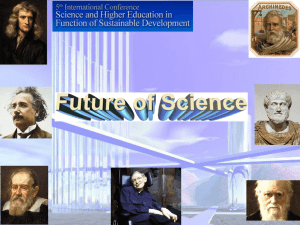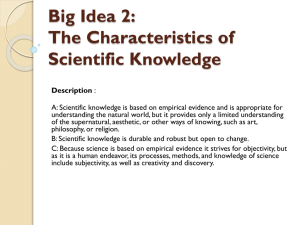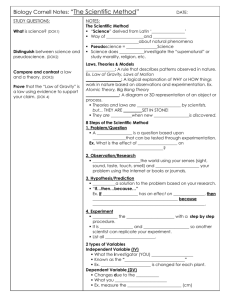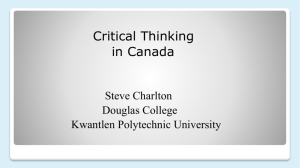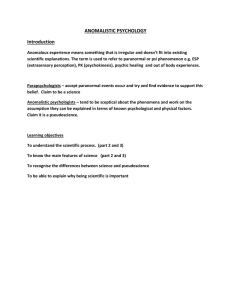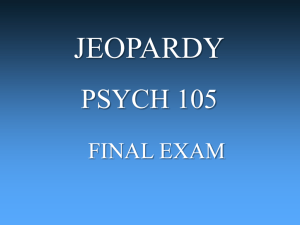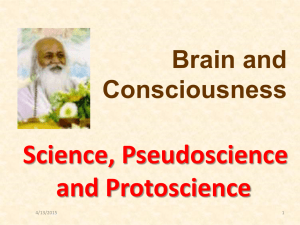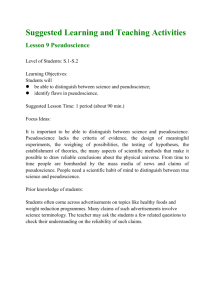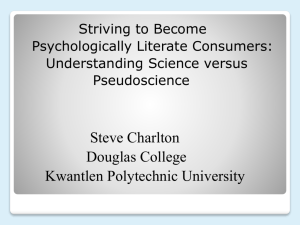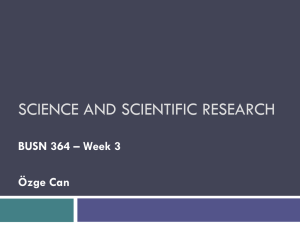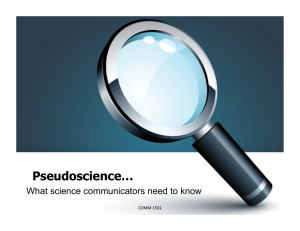Science Worksheet - faculty at Chemeketa
advertisement
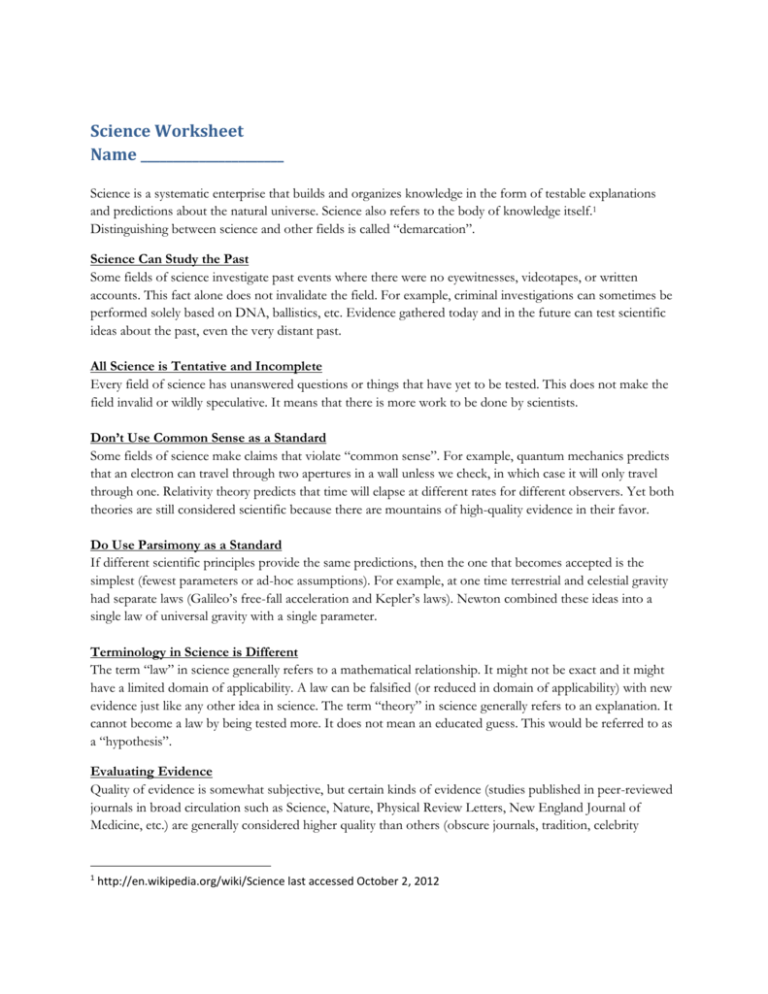
Science Worksheet Name ______________________ Science is a systematic enterprise that builds and organizes knowledge in the form of testable explanations and predictions about the natural universe. Science also refers to the body of knowledge itself.1 Distinguishing between science and other fields is called “demarcation”. Science Can Study the Past Some fields of science investigate past events where there were no eyewitnesses, videotapes, or written accounts. This fact alone does not invalidate the field. For example, criminal investigations can sometimes be performed solely based on DNA, ballistics, etc. Evidence gathered today and in the future can test scientific ideas about the past, even the very distant past. All Science is Tentative and Incomplete Every field of science has unanswered questions or things that have yet to be tested. This does not make the field invalid or wildly speculative. It means that there is more work to be done by scientists. Don’t Use Common Sense as a Standard Some fields of science make claims that violate “common sense”. For example, quantum mechanics predicts that an electron can travel through two apertures in a wall unless we check, in which case it will only travel through one. Relativity theory predicts that time will elapse at different rates for different observers. Yet both theories are still considered scientific because there are mountains of high-quality evidence in their favor. Do Use Parsimony as a Standard If different scientific principles provide the same predictions, then the one that becomes accepted is the simplest (fewest parameters or ad-hoc assumptions). For example, at one time terrestrial and celestial gravity had separate laws (Galileo’s free-fall acceleration and Kepler’s laws). Newton combined these ideas into a single law of universal gravity with a single parameter. Terminology in Science is Different The term “law” in science generally refers to a mathematical relationship. It might not be exact and it might have a limited domain of applicability. A law can be falsified (or reduced in domain of applicability) with new evidence just like any other idea in science. The term “theory” in science generally refers to an explanation. It cannot become a law by being tested more. It does not mean an educated guess. This would be referred to as a “hypothesis”. Evaluating Evidence Quality of evidence is somewhat subjective, but certain kinds of evidence (studies published in peer-reviewed journals in broad circulation such as Science, Nature, Physical Review Letters, New England Journal of Medicine, etc.) are generally considered higher quality than others (obscure journals, tradition, celebrity 1 http://en.wikipedia.org/wiki/Science last accessed October 2, 2012 testimonial, rumor, personal experience, authority, self-published work, etc.). The volume of evidence and the time it has withstood scrutiny should also be considered. Falsifiability In order to be considered well-established science, an idea must be subject to falsifiability. This means that it can be used to make predictions about future measurements, and that there are conceivable future measurements that would disprove the idea. Pseudoscience Pseudoscience is an idea that is not science, but is presented as science by some proponents. The idea might be outside the domain of science (supernatural phenomena) or poorly supported (or even contradicted) by experimental evidence. The use of the term can be considered pejorative. Here are a few common characteristics of pseudoscience: Lack of a plausible physical mechanism consistent with other scientific fields A small signal to noise ratio, causing the distinction between random chance (or placebo effects) and a true effect to be difficult to make Reliance on testimonials rather than peer-reviewed journal articles Reliance on philosophical arguments rather than measurements and calculations Lack of significant progress (failure to strengthen or consistently replicate the effect) after years of work Lack of meaningful engagement with critics and splintering into a small, closed group of adherents Appeal directly to the public through seminars or books Below is a list of phenomena along with some brief descriptions. Categorize each as one of the following: a) It is outside the domain of science (art, literature, supernatural phenomena, etc.) and few, if any, claim that it is science. b) It is outside the domain of science while some proponents claim that it is science, thus making it a pseudoscience. c) It once was within the domain of science, but it was proven false (or lacking parsimony, usefulness, or any good evidence) and no longer used. d) It once was within the domain of science, but it was proven false (or lacking parsimony, usefulness, or any good evidence). Proponents still exist, thus making it a pseudoscience. e) It is within the domain of science, but either does not yet have strong evidence or make testable predictions. f) It is within the domain of science, but evidence is seriously conflicting. g) It is science consistently supported by high-quality evidence. Description Acupuncture Anthropogenic Global Warming Astrobiology Atomic Theory Big Bang Theory Bigfoot Cold Fusion Continental Drift Theory Creation Dark Matter Theory Don Quixote Theory of Evolution Herbal Medicine Homeopathy Ideal Gas Law Law of Attraction Mona Lisa Newton’s 2nd Law Oxygen Theory of Acids Phlogiston Theory Reversion Therapy Scientology String Theory Vaccine-Autism Theory A technique of inserting and manipulating needles into specific points on the body to relieve pain or for therapeutic purposes beyond that of a placebo The Earth has measurably warmed in the last 100 years, with a significant fraction of the warming due to human activity The study of the origin, evolution, distribution, and future of extraterrestrial life Matter is composed of discrete units called atoms, as opposed to the notion that matter could be divided into any arbitrarily small quantity and retain its chemical properties The universe has expanded from a hot and dense condition billions of years ago, and continues to expand to this day An ape-like creature inhabits forests of the Pacific Northwest Electrolysis of heavy water produces fusion of hydrogen to helium Continents move and used to be in very different locations millions of years ago Humanity, life, the Earth, and the universe were created by a deity or deities Matter that does not emit, absorb, or scatter light, but does have gravitational effects and constitutes a large percentage of the matter in the universe A work of fiction written by Miguel de Cervantes The change in the inherited traits of a population of organisms through successive generations which can eventually lead to development of new species Medicine based on the use of plants and plant extracts resulting in therapeutic effects different from that of a placebo Medicine using highly diluted or nonexistent (yes, you read that correctly) ingredients resulting in therapeutic effects beyond that of a placebo The pressure, volume, number of moles, and temperature of a gas are related: PV = nRT People's thoughts (both conscious and unconscious) will significantly alter the outside physical world, independent of any communication or physical action by the thought holder A 16th century portrait painted in oil on a poplar panel by Leonardo da Vinci net force = mass*acceleration All acids contain oxygen A substance in combustible materials that is released during combustion Homosexuals can be safely and effectively turned into heterosexuals A body of beliefs and practices invented by L. Ron Hubbard Combines quantum mechanics and general relativity into a quantum theory of gravity Vaccinations cause autism in a significant number of cases Category (a-g)
